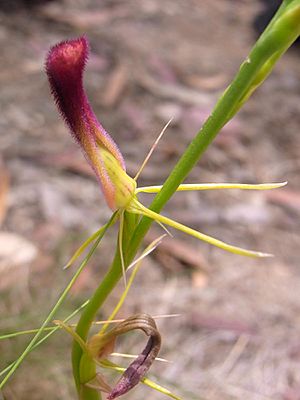Leafless tongue-orchid facts for kids
Quick facts for kids Leafless tongue-orchid |
|
|---|---|
 |
|
| Cryptostylis hunteriana in Ku-ring-gai Chase National Park, Australia | |
| Conservation status | |
| Scientific classification |
The leafless tongue-orchid (scientific name: Cryptostylis hunteriana) is a special type of flowering plant. It belongs to the orchid family and is found only in southeastern Australia. This orchid is unique because it doesn't have leaves! Instead, it grows up to ten green flowers. Each flower has a dark reddish-brown part called a labellum, which stands upright.
Contents
Discover the Leafless Tongue-Orchid's Features
The leafless tongue-orchid is a plant that grows from the ground. It is a perennial plant, meaning it lives for more than two years. It is also deciduous, which means parts of it die back each year, but the plant regrows. This orchid is a saprophyte, meaning it gets its food from dead or decaying matter, often with the help of a fungus.
Up to ten flowers grow on a stem that can be from 8 to 45 centimeters (about 3 to 18 inches) tall. Each flower is about 2 to 3 centimeters (0.8 to 1.2 inches) long and 0.6 to 0.8 centimeters (0.2 to 0.3 inches) wide.
What Does the Flower Look Like?
The most noticeable part of the flower is its spatula-shaped labellum. This part is red or maroon with a green base. It feels quite hairy. The labellum is about 2 to 3.3 centimeters (0.8 to 1.3 inches) long and 0.6 to 0.8 centimeters (0.2 to 0.3 inches) wide. Its edges are rolled inwards, and the underside is smooth.
Thin green sepals, which are like small leaves that protect the flower, grow from the base. They are about 1.5 to 2.2 centimeters (0.6 to 0.9 inches) long. The petals are similar but shorter and narrower. These orchids usually bloom from December to February.
How the Leafless Orchid Got Its Name
The leafless tongue-orchid was first officially described in 1938. This was done by a person named William Henry Nicholls. He studied a plant sample found near Marlo by William Hunter. William Hunter was a surveyor from Bairnsdale.
The description of the orchid was published in a science magazine called The Victorian Naturalist. The second part of the orchid's scientific name, hunteriana, was chosen to honor William Hunter, who found the first plant sample.
Where Does the Leafless Tongue-Orchid Live?
The leafless tongue-orchid can be found growing alone or in small groups. It lives in different types of environments. These include wet heathlands and sedgelands. You can also find it on plains where grasstrees grow.
It also lives in woodlands with trees like scribbly gum, silvertop ash, red bloodwood, and black sheoak. This orchid often grows near other tongue-orchids, such as C. subulata and C. erecta.
Specific Locations in Australia
You can find this orchid in coastal areas and nearby mountain ranges. In New South Wales, it grows south from the Gibraltar Range National Park. In Victoria, it is found in East Gippsland, between Marlo and Genoa. In Queensland, it has been seen along the coast from Tin Can Bay to the Glass House Mountains.
The Leafless Tongue-Orchid's Unique Life Cycle
Like other Australian orchids in its group, the leafless tongue-orchid has a very interesting way of being pollinated. It is pollinated by a special type of wasp called the orchid dupe wasp (Lissopimpla excelsa).
How the Orchid Tricks Wasps
Male dupe wasps mistake the orchid's flowers for female wasps. They try to mate with the flower, and in doing so, they help to spread the orchid's pollen. This is a clever trick by the orchid!
Unlike most other orchids, this one doesn't have leaves. Scientists believe it has a special relationship with a fungus. This fungus helps the orchid get the nutrients it needs to grow and survive.
Protecting the Leafless Tongue-Orchid
The total number of leafless tongue-orchids is not very high. It is estimated that there are between 1,300 and 1,500 plants in New South Wales. In Victoria, there are several hundred more.
Threats to the Orchid's Survival
The biggest danger to this orchid is the loss of its habitat. This happens because of new housing developments and the building of roads. These activities destroy the places where the orchids grow.
Because of these threats, the leafless tongue-orchid is considered vulnerable. This means it is at risk of becoming endangered. It is protected under important laws in Australia. These include the Australian Government's Environment Protection and Biodiversity Conservation Act 1999. It is also protected by the Biodiversity Conservation Act 2016 in New South Wales. In Victoria, it is listed as "endangered" under the Flora and Fauna Guarantee Act 1988.


